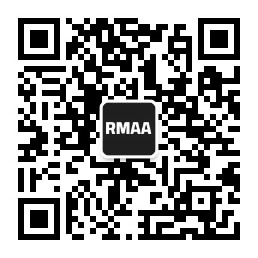Blog about successful marketing strategies in russia
Advertising creatives in Yandex.Direct. Basic formats and technical requirements

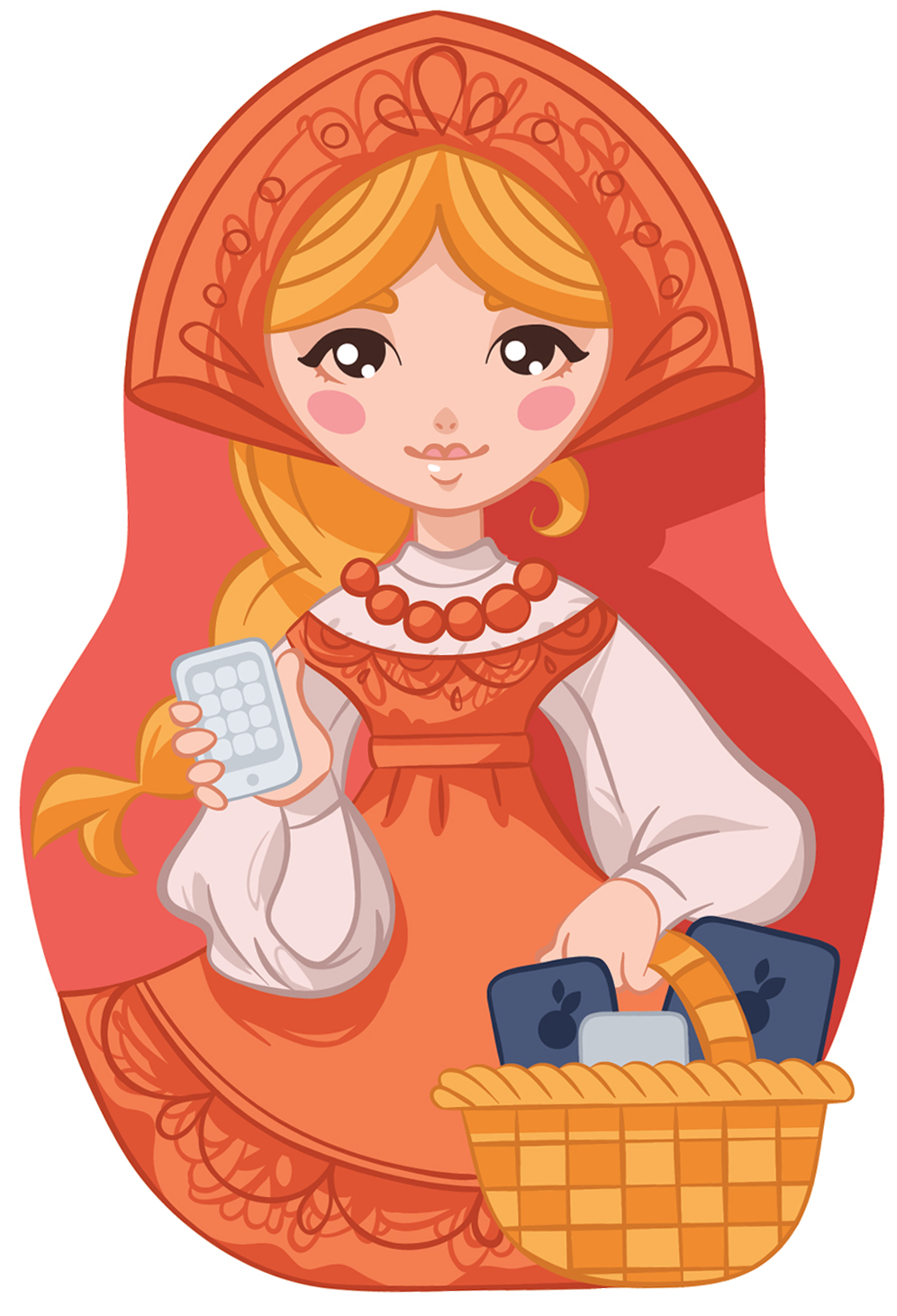
DIGITAL MARKETING
Share this Post
Different advertising platforms have their own rules to publish creatives. There is no standard size or "one-size-fits-all" parameter that would be multifunctional and universal for all services. In addition, contextual advertising has additional requirements not only for images, but also for texts.
Let's take a closer look at the formats of creatives that can be used in Yandex.Direct. RMAA experts have made a short guideline with regard to it.
Working with creatives in Yandex.Direct
Contextual advertising in Yandex.Direct is divided into 2 main types: search advertising and ads in the Yandex Advertising Networks (YAN). In the first option an advertising publication looks like a text description that is displayed on a search engine result page. In the second option there are various formats, from completely graphic and text and graphic formats to video one in mobile applications or on partner sites. But each of them has its own requirements.
Text creatives
The ad will consist of a headline, the body text, and a link to the advertised site. Ads are shown on Yandex search and networks. Basic parameters for text creatives:
- title – 56 characters with spaces and punctuation marks and a limit of 22 characters per word;
- additional title – 30 characters and 15 punctuation marks, plus, as in the title, a limit of 22 characters per word;
- ad text – 81 characters and 15 punctuation marks with limits of 23 characters per one word, and the ad text can be cut depending on the parameters of the advertising platform.
Image creatives
Properly selected images attract more attention to the advertisement and help to understand the essence of the offer faster. Ads with images are shown in the Yandex advertising network. Yandex.Direct has the following technical requirements for them:
- quality – clear images without digital noise or blurring;
- maximum file size – up to 10 MB;
- images when choosing carousel format (note - several creatives with scrolling in one ad) should be from 450 px on each side;
- additional elements – should occupy no more than ⅕ of the total area of the image (such as transition buttons, background, filling, gradient, etc.);
- format – JPG, PNG, GIF. Note that in the latter option the animated picture will not be shown entirety, only the first frame;
- size – depends on the type of advertising and devices. The following standards are applied for text and image banners: from 450 to 5000 pixels in the desktop version with acceptable aspect ratios of 1:1, 3:4 or 4:3; from 1080x607 pixels to 5000x2812 pixels for a mobile format with 16:9 ratio.
Image banners can be of various sizes for any device: 160×600, 240×400, 240×600, 300×250, 300×300, 300×500, 300×600, 320×50, 320×100, 320×480, 336×280, 480×320, 728×90, 970×250, 1000×120, 160×600, 960x640.
When displayed in the YAN (Yandex Advertising Network), ad blocks are optimized for a format of the displaying a specific partner site. That is, uploaded images can be cropped, reduced, etc. They can also be horizontal or vertical, depending on the advertising platform. It is necessary to keep this in mind when designing a creative. The formats are specified at the stage of uploading the image to the ad.
There are 3 possible options here. The first one is when the ad format is set strictly according to certain criteria. Because of this, the aspect ratio and the size in pixels do not change. If the picture does not fit into the unit, it will not stretch or shrink. The second option is to use a special creative builder, when an ad is customized individually to specific sizes. In the third option the image size may not be fixed, and the format adapts to the requirements of the YAN website (aspect ratio will change). Be sure to check the preview of the publication to see how the image looks like after reducing or adjusting the size.
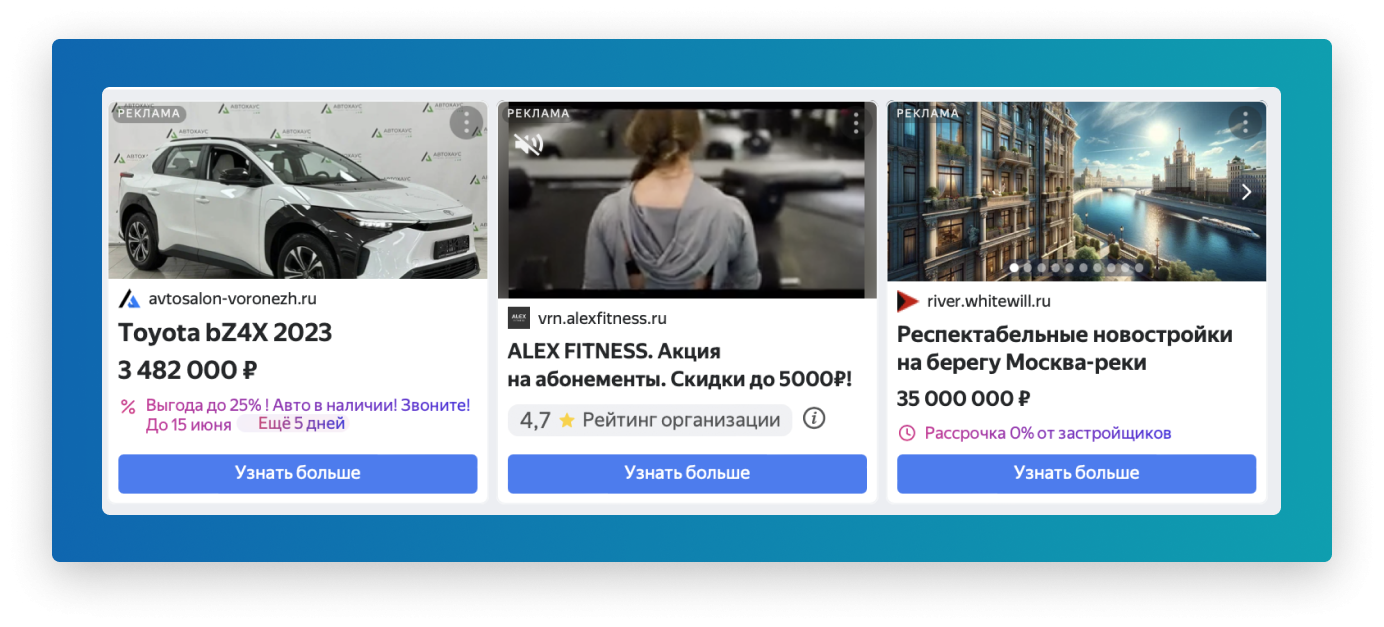
HTML5 format
An HTML5 banner is a ZIP archive containing a single HTML file and JavaScript, JSON, CSS, JPEG, GIF, PNG, SVG files. The archive and files in the HTML5 banner must comply with the requirements:
- Only Latin alphabet letters, numbers and symbols -._~ can be used in file and directory names.
- All links in the HTML5-banner must be relative and lead to other files from the archive. There should be no external network references when working off the advertisements. If necessary, all auxiliary JS libraries must be provided with the promotional materials.
- There can be no more than 20 files in the archive. It is necessary to include source code from JavaScript, CSS, SVG files into HTML file, and all bitmap images should be combined into one file (sprite atlas).
- The maximum weight of the index.html file in the archive should be less than 150 KB.
- The archive will ignore the contents of the __MACOSX folder and the .DS_Store, Thumbs.db files. These are auxiliary files of operating systems, which are not needed for the HTML5 banner to work.
- Clicking on the banner will open the page specified in the Site Link field, the mobile app (if installed) or the app page in the store (if the app is not installed). The transition to this page should be generated in the banner by calling the yandexHTML5BannerApi.getClickURLNum(1) method.
- The following banner sizes are allowed: 160×600, 240×400, 240×600, 300×250, 300×300, 300×500, 300×600, 320×50, 320×100, 320×480, 336×280, 480×320, 728×90, 970×250, 1000×120. The banner size is specified in the <meta> element.
- External calls to JavaScript libraries hosted on Yandex servers are allowed. If another library is used in the HTML5 banner, its source code must be included in the archive.
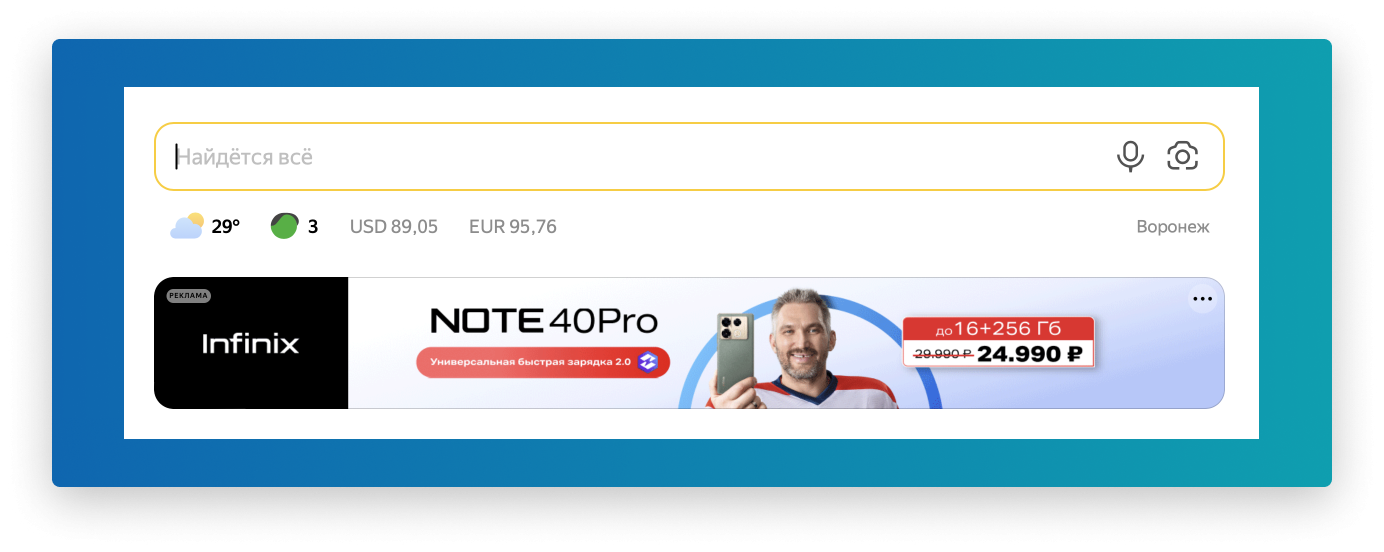
Video creatives
Particular attention should be given to the video format. It can be used instead of an image in text and graphic ads on websites where the placement of animated content is acceptable. Also, it can act as a full-fledged Display Advertising in InStream modes (streaming video at the beginning, middle and end of the main video), InPage (between blocks of text), Interstitial (before content upoading or changing), Rewarded (for mobile versions for bonuses for users after watching the video), InBanner (native placement in applications). Yandex.Direct has the following technical requirements for video formats:
- duration – between 5 and 60 seconds;
- maximum file size – up to 10 MB;
- format – MP4, WebM, MOV, QT, FLV, AVI;
- resolution – from 360 p;
- frame rate – from 20 frames/s;
- video codecs – H.264, VP6F, VP8, Theora;
- audio codecs – AAC, MP3, Vorbis;
- quality – from 44 kHz, 16 Kbit/s, stereo.
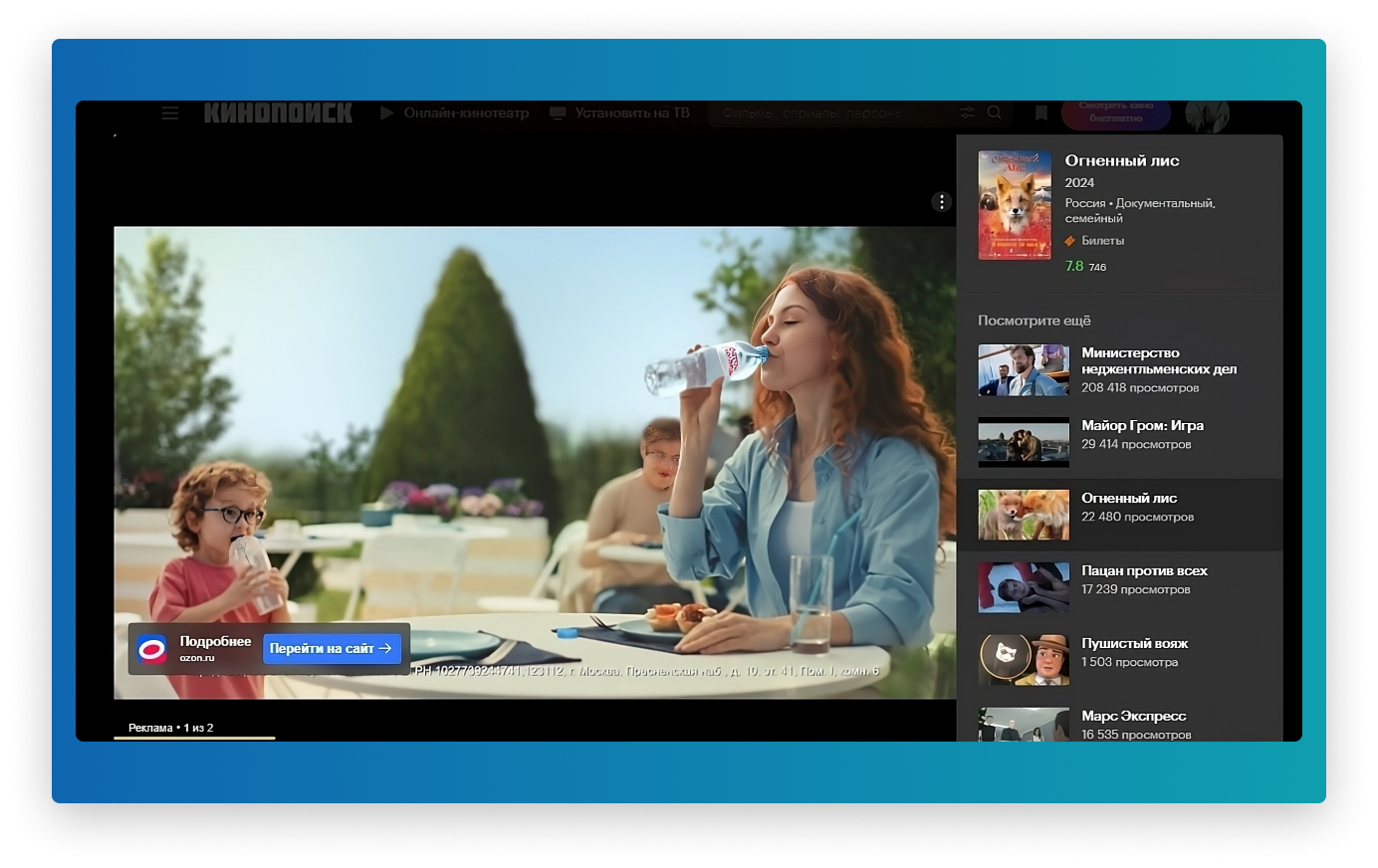
It should be noted that recently advertisers often show interest in video advertising, since it is easier to understand and remember. Nonetheless, it does not mean that other formats will be less effective.
Telegram promotional post
In 2023, Yandex.Direct added a new advertising format - placing ads in the popular messenger Telegram. Its working principle is as follows: relevant advertising will appear in the public Telegram channels of Yandex Advertising Network partners. The geography of displays is Russia only.
The creative looks like a regular channel post and contains:
- image or video up to 10MB;
- clickable headline and a link to the advertised site;
- text of the ad - maximum text length is 764 characters;
- maximum number of emoji - 5 for one ad, available for performance campaigns;
- “Advertisement” tag;
- link to the advertiser's information;
- additional elements may be added: an age tag or warning.

Regardless of the selected creatives for paid advertising in Yandex.Direct, the main task remains unchanged – the number of conversions. The more of them, the better the result. The same task is set for VK Ads platform from VK developers. Read about it in our special material.
Let's stay connected! Sign up for our newsletter for more useful and relevant information on marketing and advertising. To get in touch with an RMAA manager quickly, please fill out the feedback form in the contact page.
Join 2,000+
of your Peers!
You will be the first to know about Russian marketing insights, news and updates from our agency. Stay tuned!
Get our latest articles delivered to your email inbox and get our exclusive White Paper
"Digital Marketing in Russia. Finding your customers on the internet"
for FREE!
Russian Digital Market Overview
Strategic Insights into Russian Digital Marketing Landscape
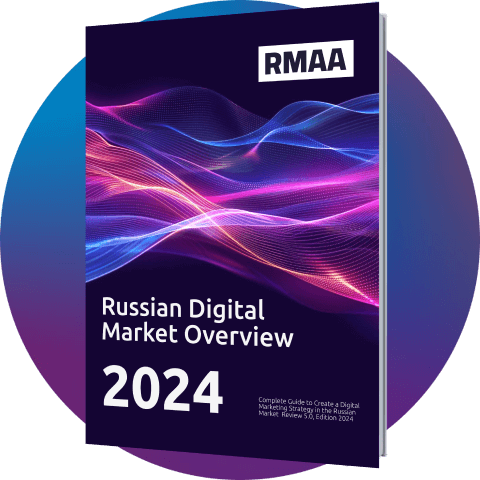
Ready to partner with the specialists in Russian marketing and advertising?
About the Author
Digital Strategist. Head of one of the project groups at RMAA. Maria started her journey in digital marketing in 2009.
Join 2,000+ of your Peers!
Get our latest articles delivered to your email inbox and get our exclusive White Paper "Digital Marketing in Russia. Finding your customers on the internet" for FREE!
You will be the first to know about Russian marketing insights,
news and updates from our agency.
Stay tuned!
We're updating our website's design step by step, so some pages may look different. Thank you for your understanding.
Got it








